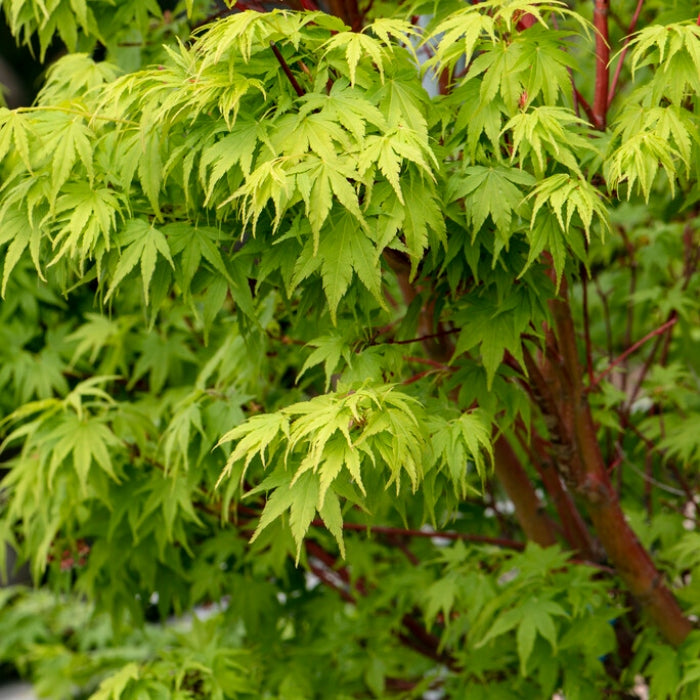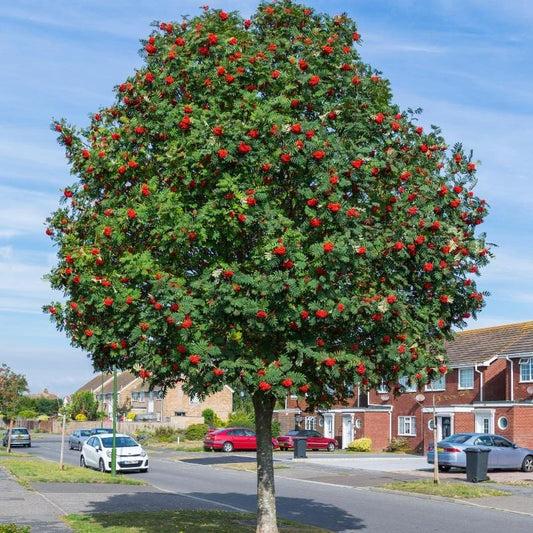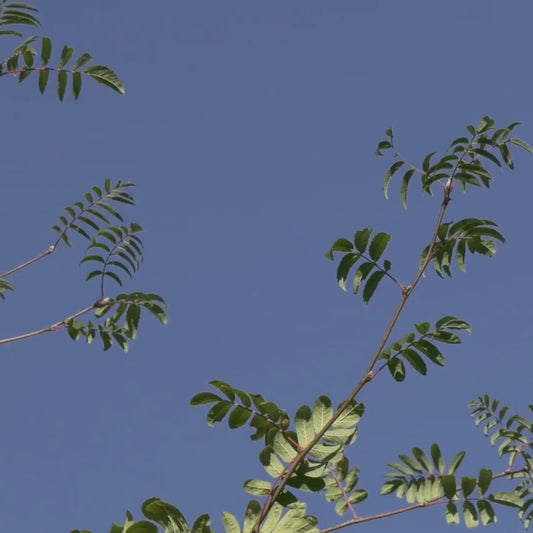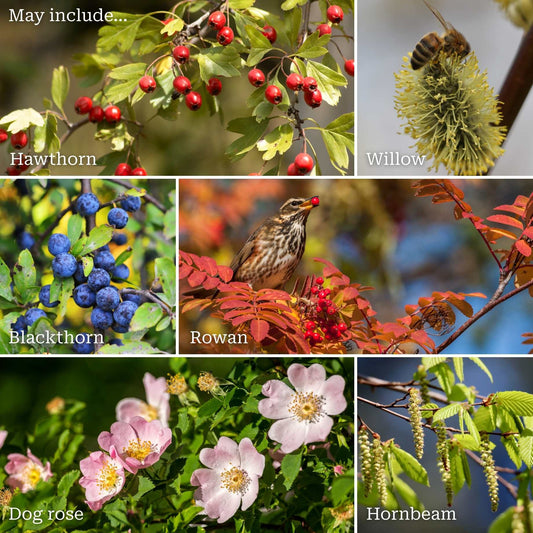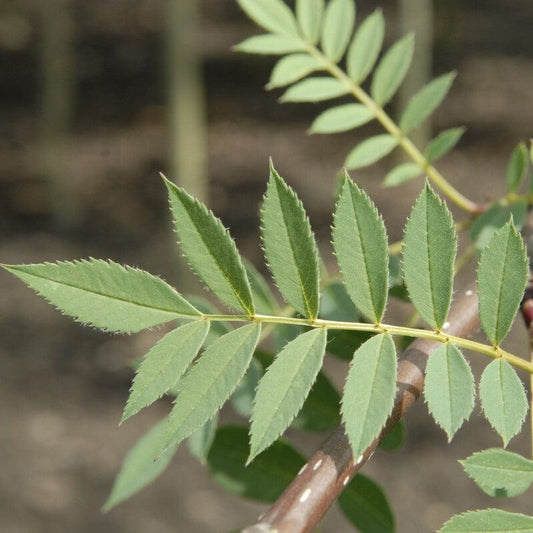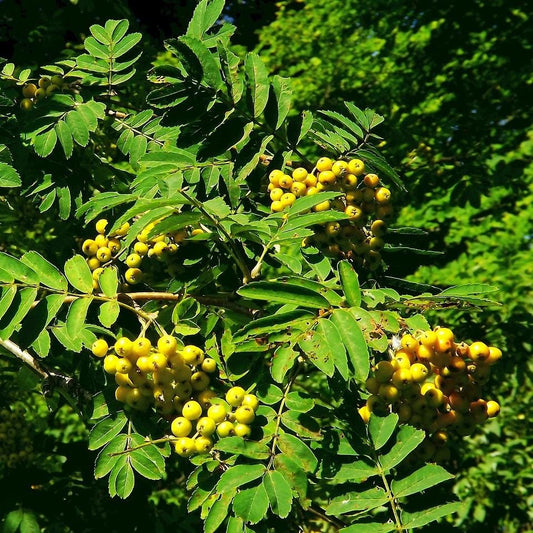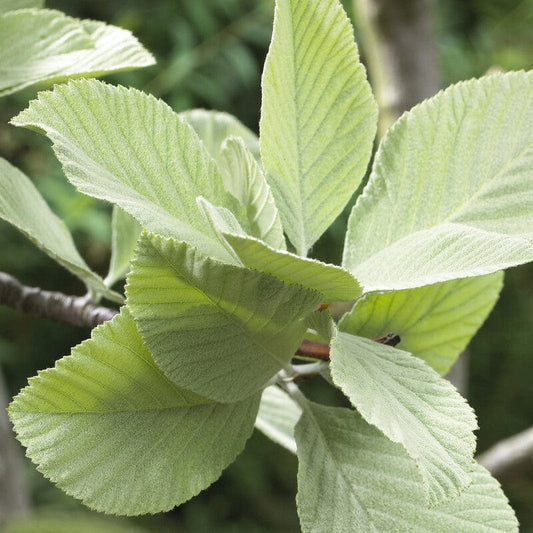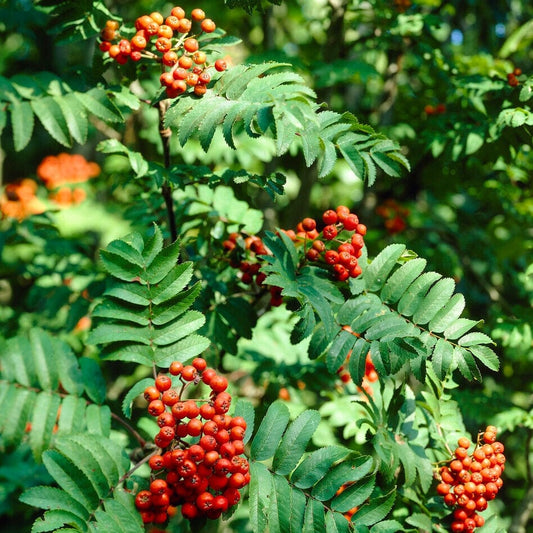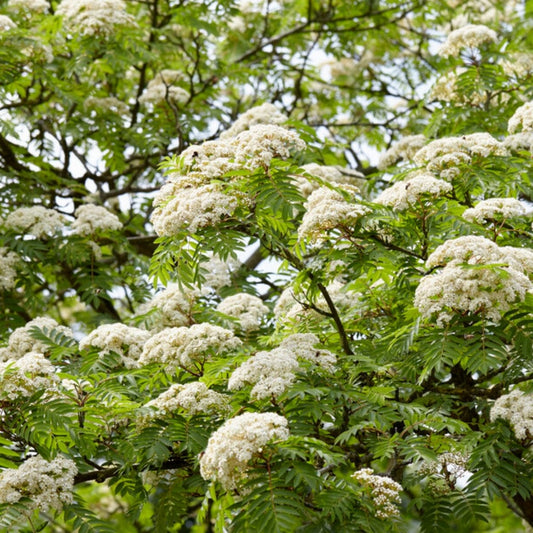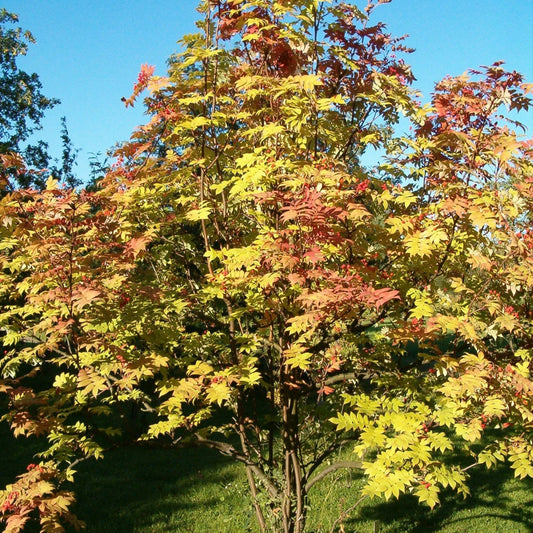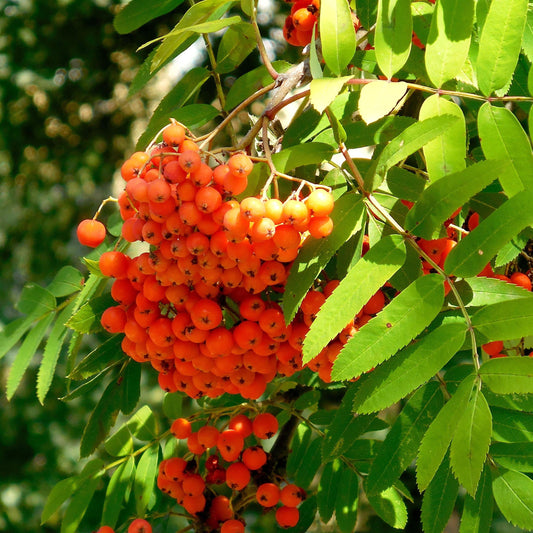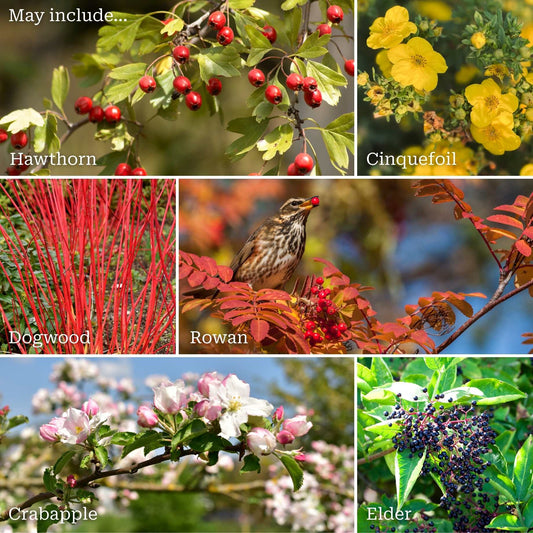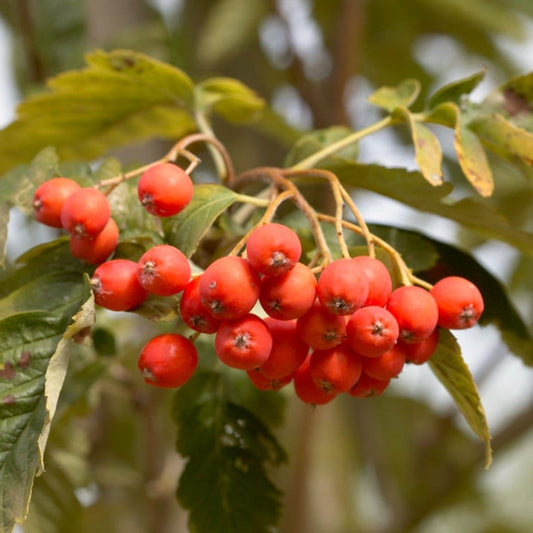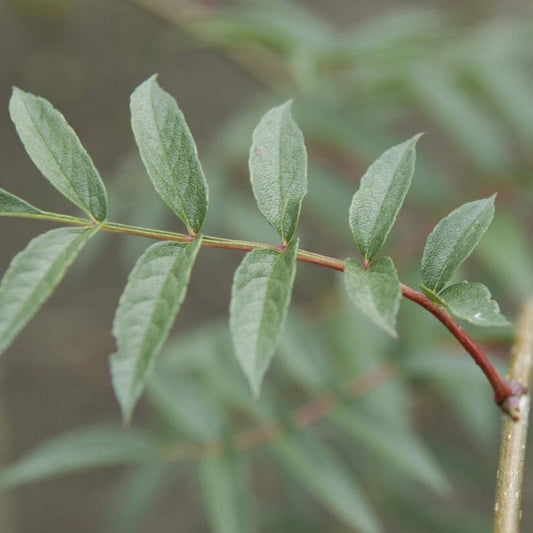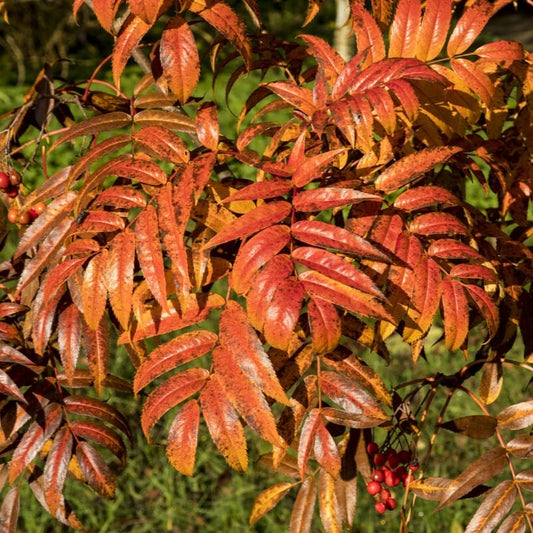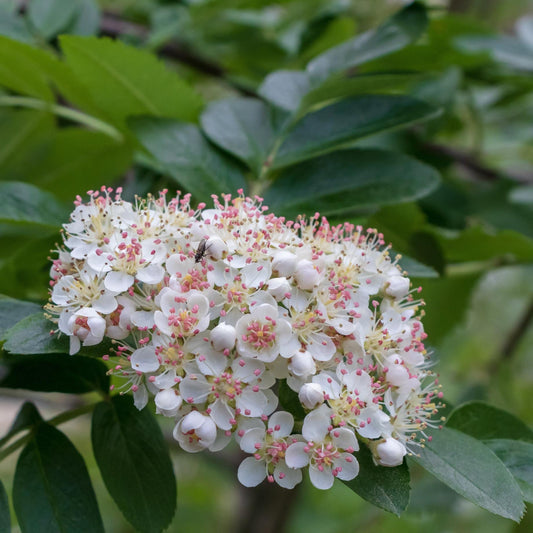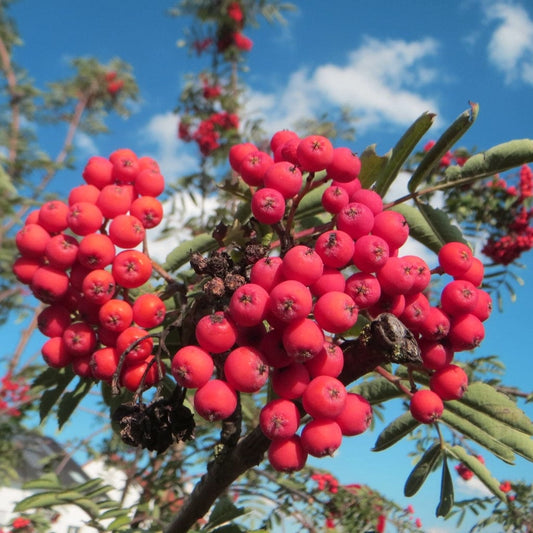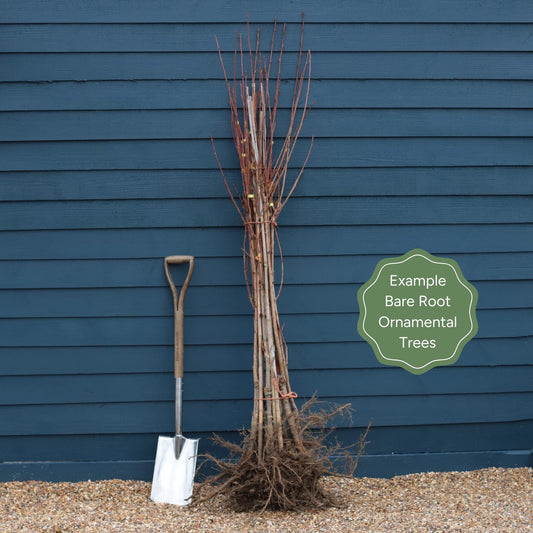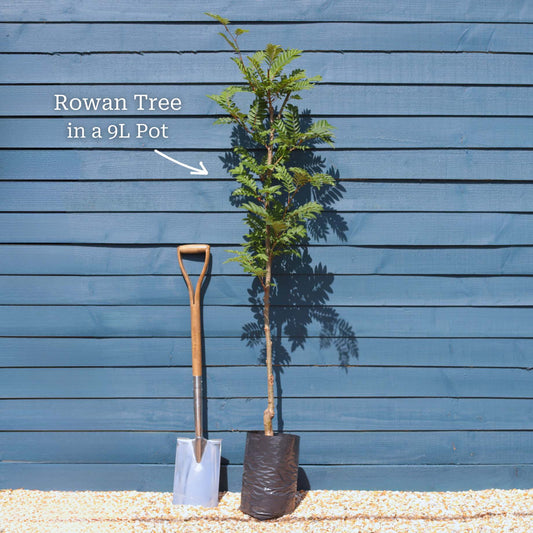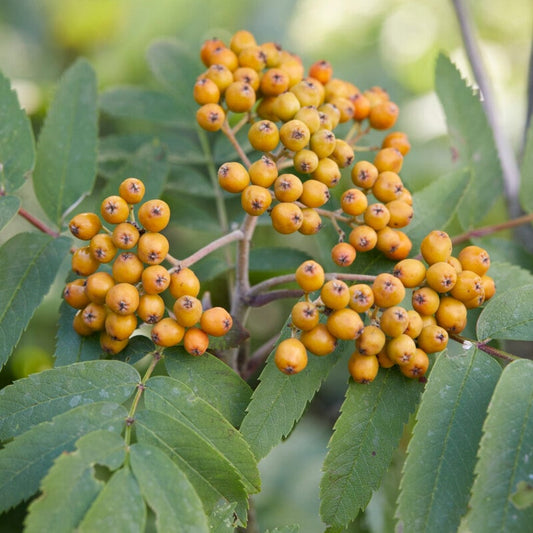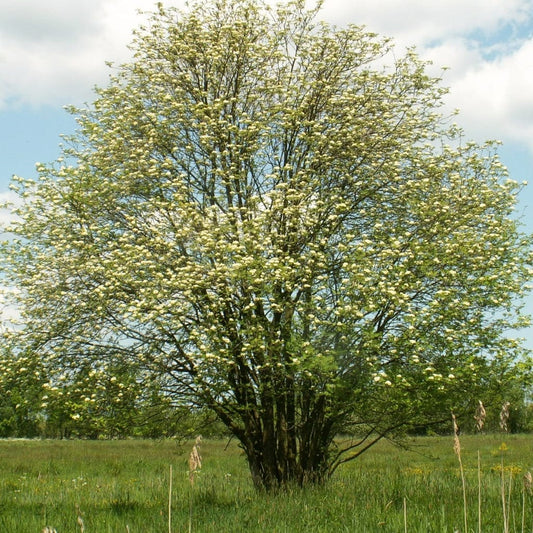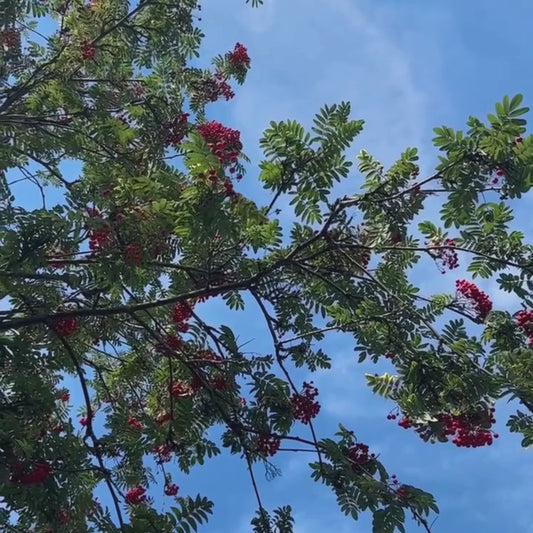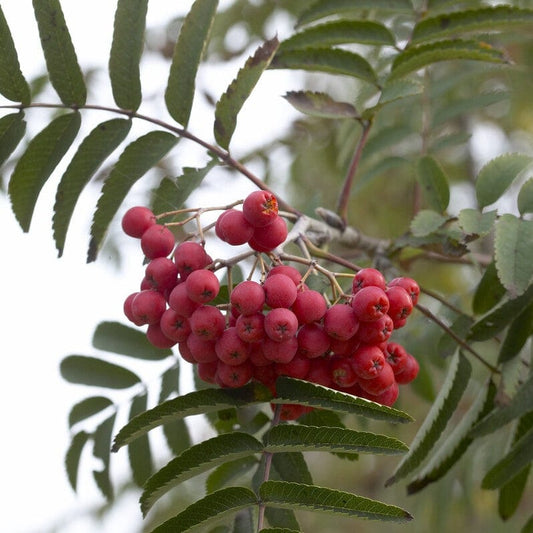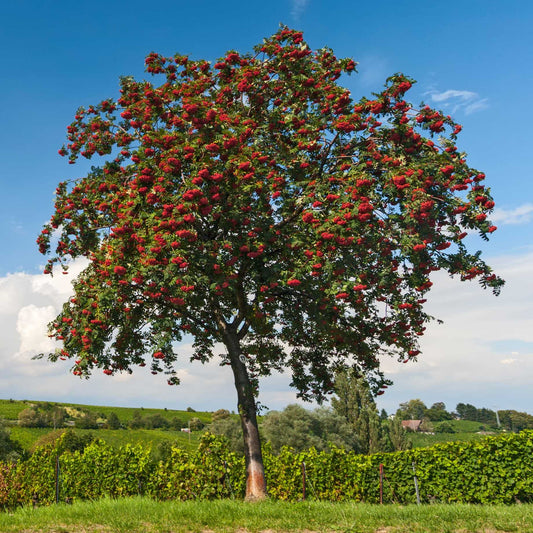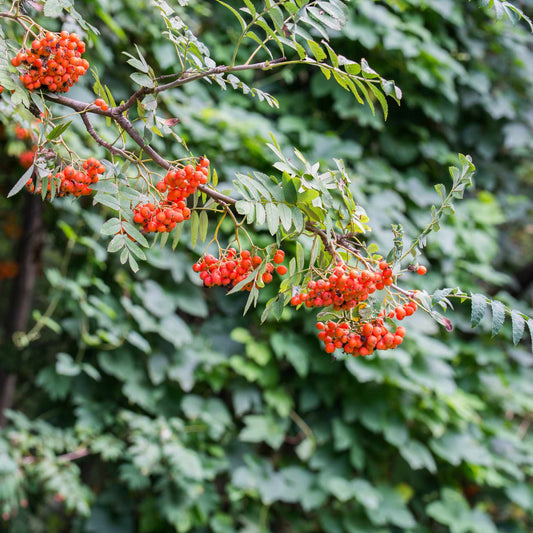Collection: Rowan Trees
If you love wildlife in your garden, a rowan is a must. With springtime blossom clouds for the bees and brightly-coloured berries for hungry birds, it’s second only to the oak in the number of species it supports, and takes up less space. Raised by experts in the field (literally), our UK-grown rowans are hardy and will brighten up your garden for decades.
Need help picking?-
Regular price From £38Regular price
£45Sale price From £38Mountain Ash Rowan Tree | Sorbus aucuparia
The ultimate wildlife tree
- Rounded, bushy tree
- Large tree - grows to 12m
- Spectacular autumn colour
- Suitable for all garden sizes
5 options available
-
Regular price From £38Regular price
£55Sale price From £38Vilmorin's Rowan Tree | Sorbus vilmorinii
Red berries turn stunning white
- Bushy, spreading tree
- Medium tree - grows up to 4m
- Green, lacy leaves turn purple come autumn
- Aids native wildlife and bees
2 options available
-
Regular price From £45Regular price
£60Sale price From £45Best Mixed Native Wildlife Hedging | Growers' Choice
An ecological haven
- Packed with colour, flowers & fruit
- Food and shelter for insects, birds & mammals
- UK native varieties handpicked by our grower
- Hardy and easy to maintain
4 options available
-
Regular price From £36Regular price
£55Sale price From £36'Pink Pagoda' Rowan Tree | Sorbus hupehensis
Myriad candy-pink berries
- Elegant, bushy tree
- Medium tree - grows up to 7m
- Lush green foliage turns crimson in autumn
- Beautiful pink-blushed berries
2 options available
-
Regular price From £35Regular price
£45Sale price From £35'Joseph Rock' Rowan Tree | Sorbus
Sunburst yellow berries
- Bushy, upright tree
- Medium tree - grows up to 7m
- Vivid red autumn foliage
- Tolerant of pollution
2 options available
-
Regular price From £30Regular price
£65Sale price From £30Whitebeam Tree | Sorbus aria 'Lutescens'
Glorious white springtime blooms
- Bushy, upright tree (spreading with maturity)
- Large tree - grows up to 10m
- Silver-green, deciduous leaves
- RHS Award of Garden Merit winner
2 options available
-
Regular price From £4Regular price Sale price From £4
Rowan Hedging | Mountain Ash | Sorbus aucuparia
Wildlife-boosting native
- White flowers and vibrant autumn foliage
- Sprays of winter berries for birds
- Average growth rate - 20-40cm per year
- Grows up to 5m or keep trimmed at 1-5m
3 options available
-
Regular price From £38Regular price
£45Sale price From £38Scarlet Japanese Rowan Tree | Sorbus commixta 'Embley'
Incredible autumn colour!
- Upright, bushy tree
- Medium tree - grows up to 8m
- Autumnal hues of purple, red and orange
- Attracts all manner of birds to your garden
2 options available
-
Regular price From £45Regular price
£55Sale price From £45All Seasons Hedging | Growers' Choice
Looks great all year round
- Flowers, berries and vibrant stems
- Packed with colour and wildlife benefits
- Premium varieties handpicked by our grower
- Easy to plant and prune
4 options available
-
Regular price £60Regular price
£65Sale price £60'Sheerwater Seedling' Sorbus Tree
A bona fide wildlife magnet
- Upright, oval tree
- Medium tree - grows up to 6m
- Vibrant orange and red autumn colours
- RHS Award of Garden Merit winner
1 option available
-
Regular price £55Regular price
£60Sale price £55Japanese Rowan Tree | Sorbus commixta 'Carmencita'
Jewel-like red autumn berries
- Fabulous upright tree
- Medium tree - grows to 4m
- Bronze autumn foliage and vivid red berries
- The stunning red fruits are loved by birds
1 option available
-
Regular price £50Regular price
£55Sale price £50Japanese Rowan Tree | Sorbus commixta 'Dodong'
An autumn colour powerhouse
- Impressive upright tree
- Medium tree - grows up to 8m
- Large pinnate leaves turn fiery in autumn
- RHS Award of Garden Merit winner
1 option available
-
Regular price From £45Regular price Sale price From £45
Kashmir Rowan Tree | Sorbus cashmiriana
Snow-white berry blizzard!
- Charming spreading tree
- Medium tree - grows up to 8m
- Oblong green foliage, linen white berries
- RHS Award of Garden Merit
1 option available
-
Regular price From £38Regular price
£50Sale price From £38Pink Berried Mountain Ash Tree | Sorbus 'Eastern Promise'
Pink berries take centre stage
- Bushy, oval tree
- Medium tree - grows up to 6m
- Pinnate leaves turn purple and red in autumn
- RHS Award of Garden Merit winner
Currently out of stock
-
Regular price From £38Regular price
£55Sale price From £38Cut Leaf Rowan Tree | Sorbus 'Chinese Lace'
Exceptionally bright red berries
- Neat, upright tree
- Medium tree - grows up to 6m
- Dark green, finely-cut leaflets (turning red)
- Ideal for city and roadside gardens
Currently out of stock
-
Regular price From £35Regular price
£45Sale price From £35'Copper Kettle' Rowan Tree | Sorbus
Unique copper-coloured berries
- Spreading, upright tree
- Medium tree - grows up to 5m
- Green leaves, white blooms, bright berries
- RHS Award of Garden Merit winner
Currently out of stock
-
Regular price From £65Regular price
£70Sale price From £65Multi-Stem Mountain Ash Rowan Tree | Sorbus aucuparia
More stems, more impact!
- Spreading, multi-branched tree
- Medium tree - grows up to 8m
- Green, pinnate leaflets take on fiery hues
- Birds love the bright-red, autumn berries
Currently out of stock
-
Regular price From £45Regular price Sale price From £45
Columnar Rowan Tree | Sorbus x thuringiaca 'Fastigiata'
Blazing orange autumn hues
- Bold columnar to oval tree
- Medium tree - grows up to 10m
- Dark green leaves, cream flowers, red berries
- Sensational autumn leaf colour
Currently out of stock
-
Regular price £100Regular price
£175Sale price £100Mountain Ash Rowan Tree | Sorbus aucuparia 'Aspleniifolia'
Berries that birds love
- Strong, bushy tree
- Large tree - grows up to 12m
- White blooms and pinnate, deciduous leaflets
- RHS Plants for Pollinators
Currently out of stock
South Downs National Park
Meet Danielle
110 years' expertise free with every tree
Danielle's nursery has been growing trees in the South Downs National Park for over a century, and it shows. Dug up and sent straight to your garden at between 18-36 months old, their quality rootstocks, expert pruning and natural pest control mean that these traditionally field-grown trees are the hardiest you can get.
Need help picking?

Which rowan tree is best for your garden?
Rowan trees are naturally compact and can be pruned to suit any size of garden. If you have the space, go all out with a mountain ash or 'Vilmorinii'. For smaller gardens we recommend a neat and compact 'Pink Pagoda' or 'Copper Kettle'. The colour of rowan berries varies from yellows ('Joseph Rock') through pinks to deep autumnal reds (Japanese rowan, whitebeam). Although some rowans can grow to around 6m, other varieties need much less space, making them a solid choice for any wildlife lover’s garden. Find the best rowan for your garden with our growers’ guide.

What grows well with rowan trees?
Rowan trees partner well with other UK native species, including birches and willows, and can be underplanted with shade-tolerant perennials or shrubs for a natural woodland look. If you don’t have space for a rowan tree, a crabapple has wildlife appeal in spades and can even be grown in a pot. You can also grow rowans as a hedge, which does the same job as well as sheltering your garden from wind, noise and pollution.

Growers' tips for rowan trees
Rowan trees do best in fertile, well drained soils - they don’t thrive in clay or waterlogged soil, but any other kind is fine. You’ll get the best flowers and berries if your tree gets at least six hours of sunlight daily, but it will also be fine with a bit of light shade. Your rowan tree needs regular watering for its first year, but after that you’ll only need to water it during hot, dry weather. Feeding isn’t necessary, but mulching once a year will help to top up the soil’s natural nutrients. When your tree is young, you may want to prune it to improve the shape of the developing crown. After that, you can leave it to its own devices unless you need to restrict its size. If you do need to prune, this should be done in autumn or early winter.
Rowan Tree FAQs
Where do rowan trees grow?
Natively, rowans are found across the UK (particularly the north of England and Scotland), Europe and China. They favour cooler climates and high altitudes, which gave rise to the common name ‘Mountain Ash’.
How fast do rowan trees grow?
Rowan is a fast-growing pioneer tree, meaning that its seeds, distributed by birds, grow quickly to colonise open ground. It grows about 20-40cm per year.
Are rowan trees evergreen?
Rowan trees are not evergreen - they lose their leaves in winter and grow fresh foliage each spring.
When do rowan berries appear?
Rowan berries appear shortly after flowering in late spring, grow over the summer and then ripen in late summer/early autumn.
Are mountain ash berries poisonous?
Rowan berries are not technically poisonous (and certainly not for birds, who gobble them down by the bucket load), but they can cause stomach ache and diarrhoea for humans when eaten raw. When cooked, they can be made into jams.
What does a rowan tree look like?
Rowan trees grow into the traditional, picture book tree shape - rounded and compact. The leaves are interesting, with five to eight pairs of serrated leaflets down each side and a final leaflet on the end giving a feathered look. They’re green through spring and summer, before turning orange in autumn. In the autumn and winter, rowan trees are coated in bright, usually red, berries.
How big do rowan trees grow?
A mature rowan can grow upwards of 15m tall in the wild, but they can be pruned to fit any size of garden and thrive as compact trees at 4-8m.
Can rowan trees be grown in pots?
Rowan trees aren’t the best species to grow in pots as they naturally grow to a large size. They are, however, quite tolerant, so you can give pot-growing a go. Just make sure to feed and water your tree regularly, repot to a larger container every few years and prune the tree to maintain a manageable height.
How long do rowan trees live?
In favourable conditions, a rowan tree can live up to 200 years.
How do you take care of a rowan tree?
Rowans are low-maintenance trees; once they’re settled in, they only need a bit of watering in very dry weather and a bit of mulch round the base once a year. New shoots may appear around the base - you can cut these off if you wish to keep a single stemmed tree. Over winter, you can prune off any dead or damaged stems.
Where is the rowan tree native to?
Rowan is native to the UK and other cooler countries in the northern hemisphere.
Happy plants make happy customers
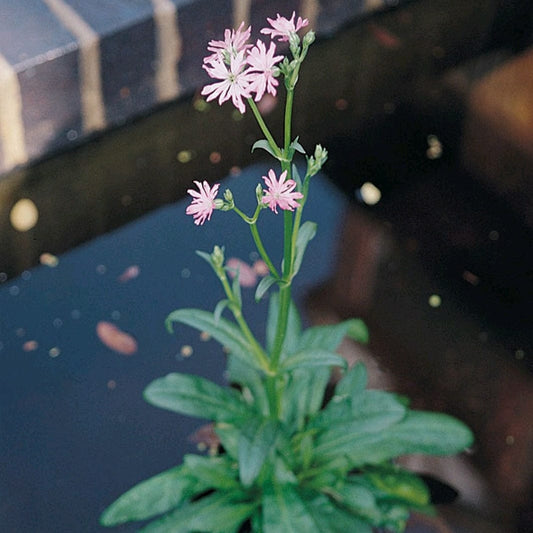
Plants arrived in great condition and very promptly. Well established - much better than the ones I got at my local garden centre.
Monica Spence
| 24 May
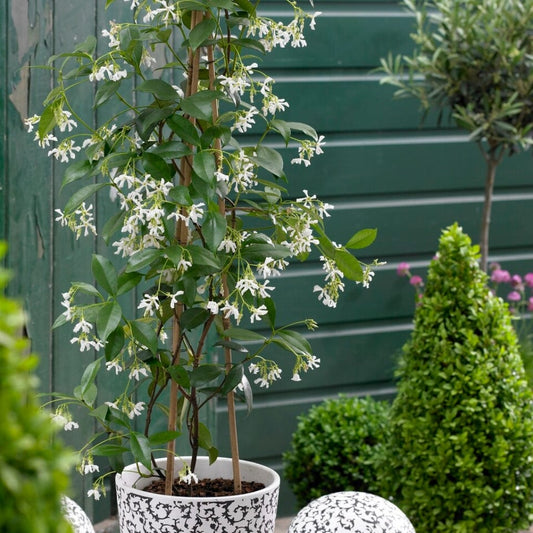
Yet again this company delivered good healthy plants, exactly as shown in photos, well packaged and within delivery time quoted. Recommend!
Jacqueline Burgess
| 2 Jun
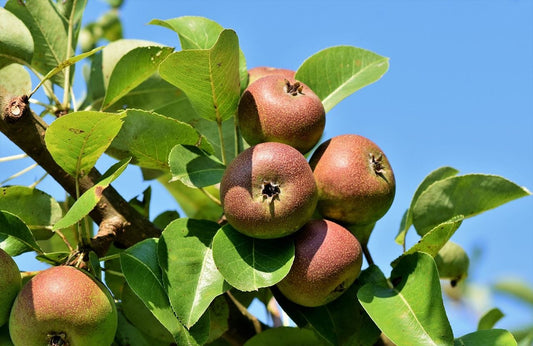
I continue to be so impressed with Roots. Their customer care, knowledge of their subject: from planting hedges to pruning roses and more, has been a great support.
Judy Lane
| 23 Oct
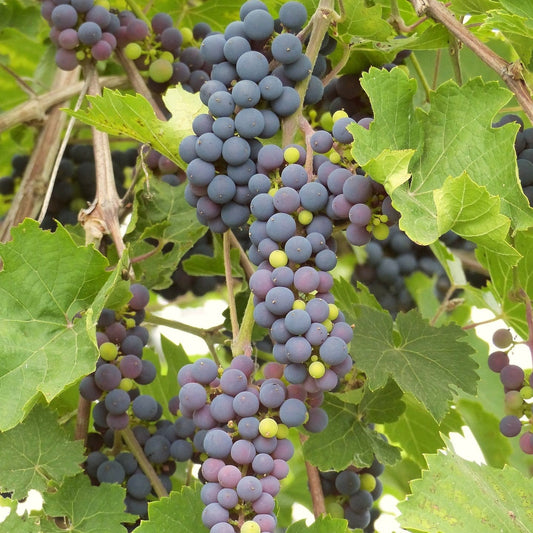
The plant arrived looking vigorously healthy, which brings a smile to your face, extremely well protected in its packaging.
Martyn Hill
| 5 Jul
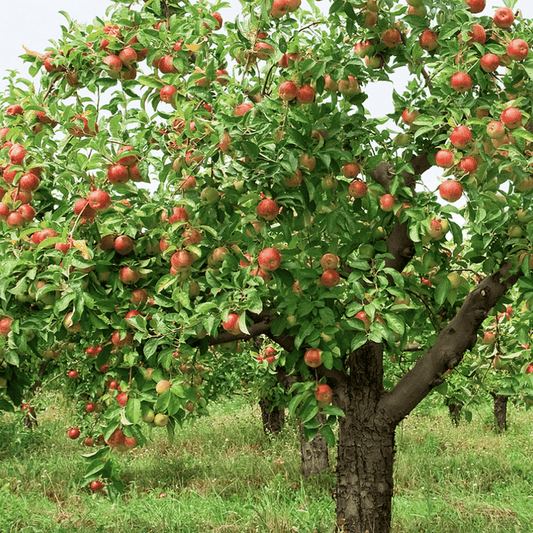
As a non-gardener, I found my whole experience brilliant. Great information & advice available on the website, great range of products & prices are brilliant.
John-Paul
| 22 May

Wonderful plants and great customer service... really surprised to find that the plants are better than those you would get at your local garden centre.
Gavin Wilcock
| 8 Nov
Fighting plastic waste
Delivering fresh from the nursery
Supporting UK growers
